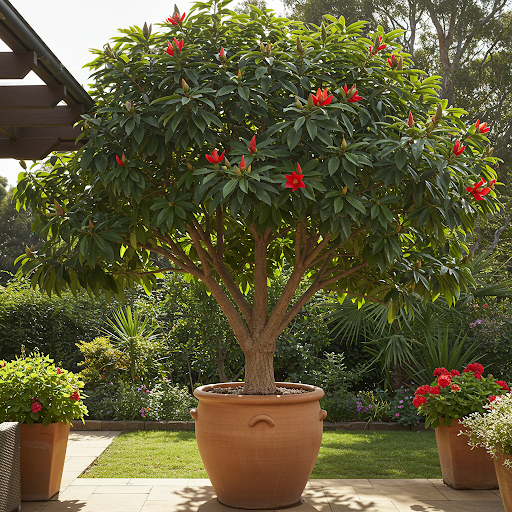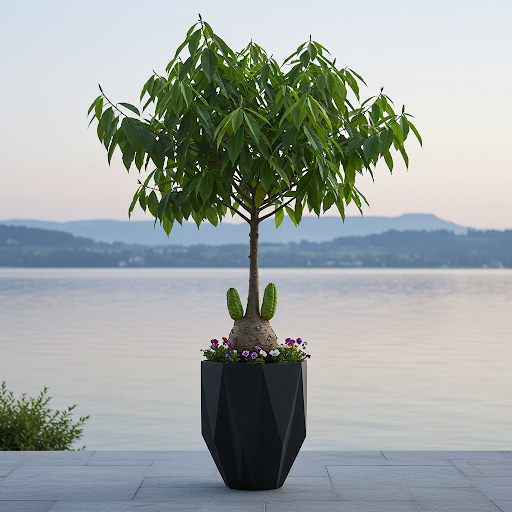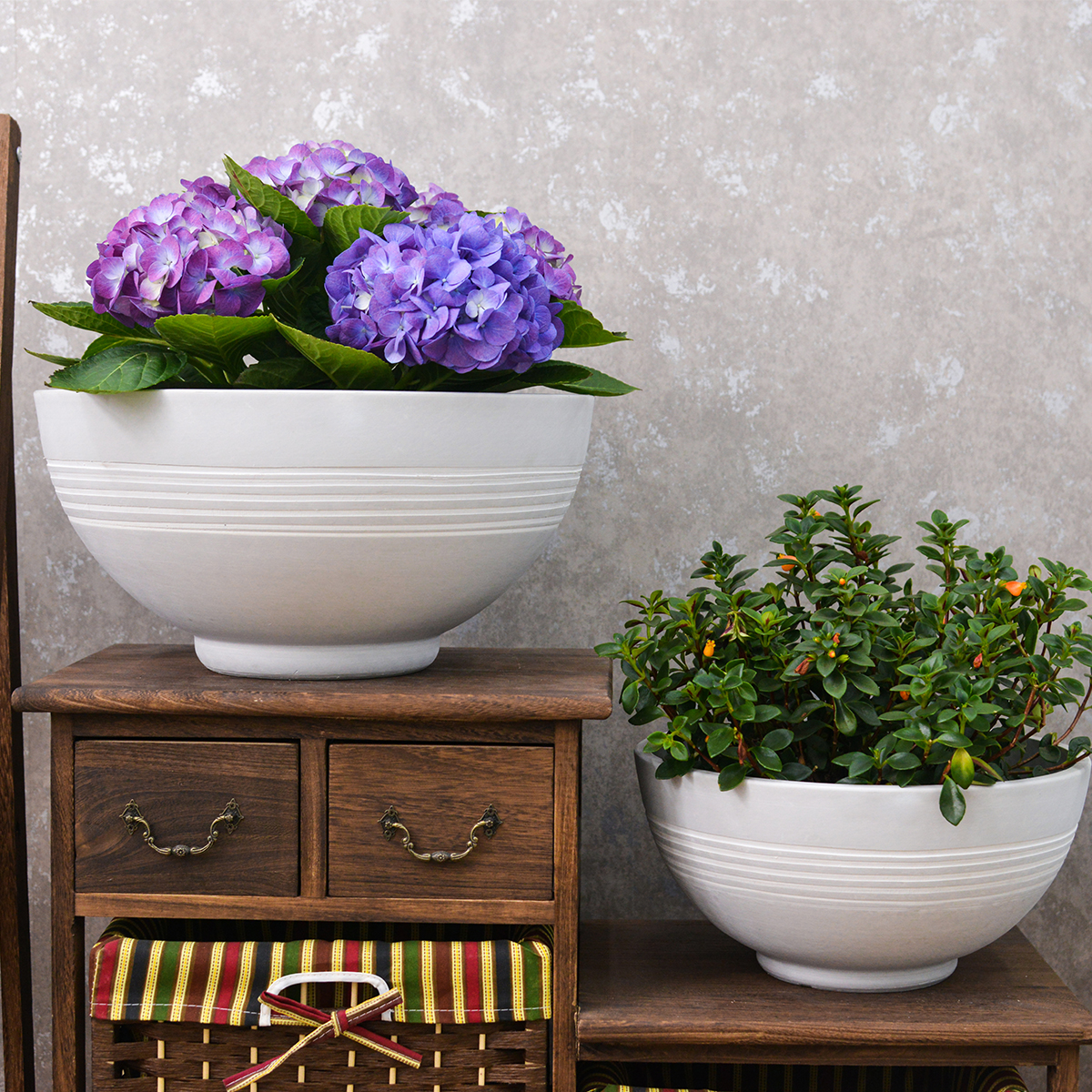Kapok Trees in Pots: The Complete Guide to Growing Majestic Kapok Outdoors in Containers (Fluffy Seed Pods & Tropical Beauty!)
Want to bring a touch of tropical grandeur and unique beauty to your garden or patio? Growing Kapok Trees (Ceiba pentandra) in containers, while ambitious, can be a fascinating way to cultivate these iconic trees, especially when young or in specific landscape designs. Celebrated for their towering presence in maturity, their distinctive, massive trunks often adorned with thorns, their impressive canopy, their unique fluffy seed pods (kapok), and their tropical allure, Kapok trees can make a striking statement, even in containers when managed appropriately. This comprehensive guide will explore the possibilities and challenges of growing Kapok trees in outdoor pots, from understanding their growth habits and container suitability to discussing essential care considerations for cultivating these majestic trees in a controlled environment.

Kapok Trees
What are Kapok Trees?
Kapok Trees, scientifically known as Ceiba pentandra, are magnificent tropical trees belonging to the Malvaceae family (Mallow family). Native to tropical regions of the Americas, West Africa, and Southeast Asia, they are renowned for their impressive size and stature, often reaching towering heights in their native habitats, their distinctive, bottle-shaped trunks frequently covered in thorns or conical spines, their expansive, spreading canopies, their large, palmate leaves, and their characteristic seed pods filled with silky, cotton-like fiber called kapok. Kapok trees are deciduous, typically losing their leaves in the dry season, and produce showy, creamy-white or pink flowers before leafing out again. However, they are primarily known for their large, oblong seed pods that split open when mature, releasing masses of light, fluffy kapok fiber, which has historically been used for stuffing pillows, mattresses, and life jackets due to its buoyancy and water resistance. Kapok trees are fast-growing in warm climates and are culturally significant in many regions, often associated with legends and traditional uses. They are iconic trees of tropical landscapes, known for their majestic presence, ecological importance, and valuable fiber.
Are Kapok Trees Good for Outdoor Pots?
Growing Kapok trees in pots is not a typical or long-term practice due to their immense size and rapid growth in their natural environment. Kapok trees are massive trees that can reach heights of 70-200 feet (20-60 meters) or more in the wild and develop extensive root systems. Container growing will severely restrict their growth and prevent them from reaching their full potential size and grandeur. However, growing Kapok trees in pots can be considered for specific purposes and with careful management:
- Temporary Cultivation of Young Trees: Kapok trees can be started in containers when young, for the first few years of their life, before being transplanted into the ground in suitable climates or used for specific short-term displays. This allows for easier management of seedlings and young saplings.
- Patio or Conservatory Specimens (with extreme size control): In very large containers and with aggressive pruning and root restriction, it might be possible to maintain a Kapok tree as a much smaller, bonsai-like specimen for a patio or large conservatory setting in warmer climates. However, this would require significant effort and expertise in bonsai or advanced container gardening techniques. Flowering and pod production would be unlikely in severely restricted containers.
- Educational or Novelty Purposes: Growing a Kapok tree in a pot can be an interesting educational project to observe its early growth stages, unique trunk development, and foliage, even if it will never reach its full size. It can be a novelty to have a Kapok tree on a patio for a limited time.
- Climate Limitations (Singapore): In Singapore’s tropical climate, Kapok trees can potentially grow quite large even in containers over time if not heavily managed. Container growing may offer a way to somewhat control their ultimate size compared to planting directly in the ground in a small garden. However, for most home gardens in Singapore, planting Kapok trees in the ground is more common if space allows, rather than long-term container cultivation.
Challenges of Growing Kapok Trees in Pots:
- Size and Growth Rate: Kapok trees are extremely fast-growing and become enormous. Container growing will drastically limit their size, but they will still try to grow rapidly and may quickly outgrow smaller pots.
- Root System: They develop extensive and powerful root systems that will become pot-bound relatively quickly, requiring frequent repotting into progressively larger containers, which becomes impractical for mature trees.
- Stability: Even in containers, Kapok trees can become top-heavy as they grow taller, making them prone to toppling, especially in windy conditions. Very large, heavy, and stable pots would be necessary.
- Pruning Demands: To maintain a Kapok tree at a manageable container size, very heavy and regular pruning of both the branches and roots would be essential, which can be challenging and may detract from the tree’s natural form.
- Flowering and Fruiting (Kapok Pods): Container-grown Kapok trees are unlikely to flower or produce their characteristic kapok seed pods, as these processes are usually associated with mature trees in the ground.
- Lifespan in Containers: The lifespan of a Kapok tree severely restricted in a container is likely to be significantly shorter than that of a tree planted in the ground.
- Aesthetic Limitations: A Kapok tree confined to a pot will never achieve the majestic, towering presence that is its hallmark. It will be a drastically scaled-down version, and may look somewhat unnatural in proportion.
If you decide to try growing a Kapok Tree in a Pot (understanding the challenges):
Types of Kapok Trees (Species and Cultivars): There are not really specific “varieties” of Kapok trees bred for container growing, as container cultivation is not typical. You would be growing the standard species Ceiba pentandra. Focus on obtaining a healthy seedling or young sapling to start with.
Light: Kapok trees are full sun trees. They need at least 6-8 hours of direct sunlight per day, and ideally more, to thrive. When grown in pots outdoors, place them in the sunniest location possible in your garden or patio. They will not do well in shade.
Soil: Kapok trees are adaptable to a range of soil types in the ground, but for container growing, well-draining, fertile soil is essential. Use a high-quality potting mix amended for trees and shrubs, or a robust general-purpose potting mix. Amend potting mix with compost, well-rotted manure, and perlite or vermiculite to improve fertility, drainage, and aeration. Excellent drainage is crucial to prevent root rot, especially in containers. Kapok trees prefer slightly acidic to neutral soil pH (around 6.0-7.0).
Watering: Kapok trees are relatively drought-tolerant once established in the ground, but young trees and container-grown trees need regular watering, especially during the growing season. Water deeply when the topsoil feels dry. Water thoroughly until water drains out of the drainage holes. Then, allow the topsoil to dry out somewhat before watering again. Avoid overwatering and consistently soggy soil, but also avoid prolonged drought stress, especially for young trees in pots. Watering frequency will depend on weather conditions, pot size, and the tree’s growth stage. Water more frequently during hot, sunny, and windy weather, and less frequently during cooler, cloudier periods and in the dormant season (if any dormancy occurs in Singapore’s climate). Reduce watering in winter if growth slows down.
Temperature: Kapok trees are tropical trees and thrive in warm to hot temperatures, ideally between 70-95°F (21-35°C) during the growing season. They are not frost-tolerant and are best suited to tropical and subtropical climates like Singapore. They will not tolerate freezing temperatures. Singapore’s warm, humid climate is generally suitable for Kapok tree growth, although container trees may need some protection from very intense afternoon sun when young.
Humidity: Kapok trees prefer moderate to high humidity, reflecting their tropical origins. Singapore’s humidity is generally well-suited to Kapok trees.
Fertilizer: Kapok trees are relatively fast-growing and benefit from regular fertilization, especially when young and when grown in containers, to support their growth. Fertilize monthly during the active growing season (spring and summer). Use a balanced fertilizer (e.g., 10-10-10 or 20-20-20) or a fertilizer formulated for trees and shrubs. Follow product label instructions for application rates, and perhaps use a slightly diluted strength for container trees to avoid salt build-up. Reduce or stop fertilizing in late summer or fall as growth naturally slows down.
Choosing Very Large and Stable Pots for Kapok (If Attempting Container Growing):
Suitable Pot Types (Extremely Large and Robust): If you are determined to try growing a Kapok tree in a pot, you will need to choose the largest, sturdiest, and most stable pots imaginable. Suitable pot types (in very large sizes) might include:
- Extra-Large, Heavy-Duty Resin or Fiberglass Pots: These are lighter than concrete but can still be made very large and robust. Choose the thickest, most stable resin or fiberglass pots available, designed for large trees. Ensure UV resistance for outdoor use.
- Very Large, Reinforced Plastic Pots: Extremely large, heavy-duty plastic pots (like those used in commercial nurseries for trees) could be used, but stability and long-term durability might be a concern. Choose the sturdiest, thickest plastic available and consider reinforcing the base.
- Custom-Built Wooden Planters (Very Large and Strong): You could construct a very large, robust wooden planter box from thick, weather-resistant lumber. Ensure it is heavily reinforced and lined to prevent rot. Wooden planters can offer a natural look and can be built to custom sizes.
- Concrete Containers (Extremely Large): Pre-cast concrete containers, if you can find them in extremely large sizes, would offer maximum stability and durability. However, they are incredibly heavy and difficult to move.
Drainage (Crucial in Large Pots): Excellent drainage is absolutely essential, even in very large pots, to prevent waterlogging at the bottom. Ensure the pot has multiple large drainage holes at the bottom. Use a very substantial drainage layer at the base of the pot (e.g., a thick layer of coarse gravel or crushed stone) beneath the potting mix to promote drainage in the large volume of soil.
Pot Size (Massive is Necessary): For even a young Kapok tree to survive in a pot for any length of time, you will need an enormous pot.
- Minimum Starting Pot Size (for a young sapling): At least 24 inches in diameter and 24 inches deep, and preferably larger.
- Ideally, for a few years of growth: Pots that are 36 inches in diameter and 36 inches deep or larger would be better to accommodate some root development and delay pot-bound conditions.
- For any semblance of long-term container growing (highly challenging): You would need pots that are 48 inches in diameter and 48 inches deep or even larger. Think of containers designed for semi-mature trees in commercial settings.
- Depth is critical: Pots should be at least 24-36 inches deep or more to accommodate the developing taproot and root system.
Stability (Paramount): Stability is paramount for container-grown Kapok trees due to their potential height and top-heaviness. Choose extremely heavy pots made of concrete, very thick terracotta, or robust, weighted resin/fiberglass. Wider pots are generally more stable than tall, narrow pots. Consider weighting the base of the potwith heavy stones or concrete blocks to further enhance stability, especially in windy areas. Position the pot in a sheltered location if possible to minimize wind exposure.
Material (Durability and Insulation): Choose pot materials that are durable, weather-resistant, and can provide some insulation to the roots from extreme temperature fluctuations. Thick-walled terracotta, heavy-duty resin, or wood can offer some insulation. Avoid thin plastic pots.
Essential Care Tips for Kapok Trees in Pots (If Attempting):
- Watering: “Water Regularly, Allow Topsoil to Slightly Dry Between Waterings”. Water deeply when topsoil is dry, ensure excellent drainage. Avoid overwatering.
- Sunlight: Provide Full Sun (at least 6-8 Hours Daily). Full sun is essential for Kapok tree growth.
- Fertilizing: Fertilize Monthly During Growing Season with Balanced Fertilizer. Regular fertilization is needed to support rapid growth.
- Pruning (Heavy and Regular Pruning is Essential for Size Control): Very heavy and regular pruning will be absolutely necessary to try to control the size and shape of a container-grown Kapok tree. This will likely involve:
- Annual or semi-annual hard pruning of branches: To limit height and spread.
- Root pruning every 1-2 years when repotting: To manage root growth and prevent pot-bound conditions (repotting itself will be a massive undertaking).
- Shaping and structural pruning: To maintain a somewhat balanced and aesthetically acceptable form in a container.
- Be aware that heavy pruning may affect the tree’s natural form and vigor.
- Support (May be Needed for Stability): Depending on the tree’s growth and pot stability, you may need to provide additional support, such as staking or bracing, especially in windy locations.
- Repotting (Frequent Repotting into Progressively Larger Pots – Until Impractical): Expect to repot a Kapok tree frequently, every 1-2 years initially, and then less frequently as it matures (but repotting will always be a major task due to the size and weight). Each repotting will require a significantly larger and heavier container until it becomes practically impossible to repot further.
- Pest and Disease Control: Monitor for pests and diseases, although Kapok trees are generally relatively resilient. Ensure good air circulation and healthy growing conditions to minimize problems.
Flowering and Kapok Pods in Containers:
It is highly unlikely that a Kapok tree grown in a container, especially one that is heavily pruned and root-restricted, will ever flower or produce its characteristic kapok seed pods. Flowering and fruiting typically occur on mature trees in the ground that have reached a significant size. Container growing is primarily for novelty or temporary cultivation of young trees, not for expecting typical Kapok tree features like flowers and pods.
In Summary (Container Growing Kapok – Highly Challenging and Not Recommended for Long-Term):
Growing Kapok trees in outdoor pots is extremely challenging and not generally recommended for long-term cultivation due to their immense size and rapid growth rate. It is only feasible for temporary cultivation of young trees, for novelty purposes, or for highly skilled gardeners attempting bonsai-like size control in very large containers. If you choose to attempt it, be prepared for significant challenges in terms of pot size, stability, watering, fertilization, and, most importantly, heavy and regular pruning to manage the tree’s vigorous growth. Flowering and kapok pod production are unlikely in container-grown Kapok trees.

Kapok Trees
Important Note: Growing Kapok trees in pots is a very ambitious undertaking and is not for the faint of heart. If you are interested in enjoying Kapok trees, it is best to appreciate them in parks, botanical gardens, or natural landscapes where they can grow to their full, magnificent potential. Container growing should only be considered for very specific, limited purposes and with a full understanding of the significant challenges involved.
k2-21G
By greenship|2024-08-13T06:17:26+00:00August 13, 2024|Categories: Hand-carving Series|
KC3-09k
By greenship|2024-08-16T06:24:36+00:00August 16, 2024|Categories: Hand-carving Series|
KC3-14A
By greenship|2024-08-16T06:26:30+00:00August 16, 2024|Categories: Hand-carving Series|
KC2-11V
By greenship|2024-08-16T05:39:50+00:00August 16, 2024|Categories: Hand-carving Series|
20T
By greenship|2024-08-13T06:42:22+00:00August 13, 2024|Categories: Hand-carving Series|
Modern Plant Pots丨Planter for Indoor Plants,8 inch or 10 inch Plant Pots with Drainage Hole,Decorative Flower Pots
By greenship-seo|2025-04-10T08:32:55+00:00January 7, 2025|Categories: Hand-carving Series|Tags: Decorative Flower Pots, Self-Watering Pots|






